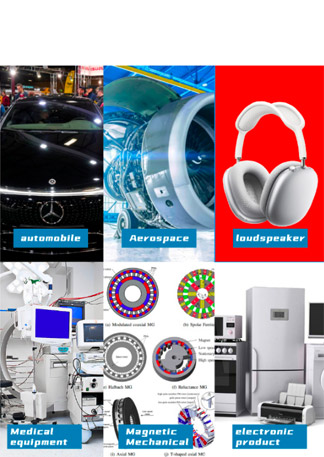NdFeB permanent magnets are the materials with the highest magnetic energy product (BHmax) among commercial magnets (up to 50MGOe or more). This feature enables them to generate high-intensity magnetic fields in a very small volume. For example, in magnetic resonance imaging (MRI) equipment, NdFeB magnets are used to manufacture compact permanent magnet systems. Their magnetic field uniformity and stability are significantly better than traditional electromagnets, which not only reduces the size and energy consumption of the equipment, but also makes open MRI design possible, greatly alleviating the claustrophobia of patients.
In addition, in implantable medical devices (such as cochlear implants and pacemakers), the high magnetic energy product of NdFeB magnets supports device miniaturization while ensuring signal transmission efficiency and reliability. Taking cochlear implants as an example, the efficient magnetic coupling between its external magnet and the implant directly depends on the strong magnetism of NdFeB, allowing patients to stably receive sound wave signals.
Medical devices have extremely stringent requirements on material stability and biocompatibility. NdFeB magnets can maintain stable performance in complex environments such as humid and high-temperature disinfection through surface coating technology (such as nickel and epoxy resin coating). For example, in surgical robots, NdFeB magnets are used to drive precision robotic arm joints. Their high temperature resistance (working temperature can reach above 150°C) enables them to withstand repeated high-temperature sterilization treatments to avoid positioning deviations caused by magnetic performance attenuation.
At the same time, in targeted drug delivery systems, the combination of NdFeB magnets and drug carriers requires long-term contact with body fluid environments. By optimizing the coating process, its corrosion resistance has passed ISO 10993 biocompatibility certification to ensure long-term safe use in the human body.
The rapid response capability and precise magnetic field control of NdFeB magnets provide key support for the intelligentization of medical technology. In magnetic navigation surgery systems, doctors use external magnetic fields to accurately control catheters or microrobots to enter human targets to complete vascular intervention or tumor ablation. This process relies on the gradient magnetic field generated by the NdFeB magnet array, and its dynamic adjustment accuracy can reach sub-millimeter level.
In addition, in the field of cancer magnetic hyperthermia, the synergistic effect of NdFeB magnets and magnetic nanoparticles can achieve local heating through alternating magnetic fields, accurately killing cancer cells without damaging healthy tissues. Experimental data show that NdFeB-based magnetic hyperthermia equipment can improve treatment accuracy to the cellular level.
Although there are supply chain challenges for the raw materials of NdFeB magnets (such as rare earth elements such as dysprosium and terbium), their ultra-long service life and recyclability significantly reduce the full life cycle cost of medical equipment. Taking a permanent magnet MRI device as an example, the life of its magnet system can reach more than 20 years, and the maintenance cost is only 1/3 of that of traditional superconducting MRI. With the advancement of rare earth recovery technology (such as hydrogen crushing purification), the sustainability advantages of NdFeB magnets will be further highlighted, helping high-end medical technology to sink to the grassroots market.
 HC Magnets
HC Magnets
The company has eight advanced production lines of electroplating process, which can fully ensure customers' various difficult requirements for product coating. And relying on Ningbo's strong front processing capacity, it can stably process and produce N52,N42,N50M,N48H, and other high-performance ndFeb. We are well-known in China and have received welcome from various buyers for on-site inspections, Accept testing and provide free samples Founded in 2017, formerly known as Hangzhou Jiahe Magnetic Ware Factory was established in 2005, Hangzhou Heci Technology Co., Ltd. has been engaged in magnetic industry for 18 years. It is a new high-tech enterprise integrating production, processing, and sales, specializing in the production of permanent magnet materials such as NdFeB magnets. The company is now located in Ningbo, the eastern port city of Yangtze River Delta. The company has the capacity of processing 1000 tons of high performance NdFeB magnets per year. Our products are mainly sold to India, Vietnam and Germany.
Resources
News
- What are the advantages of using NdFeB Magnets in medical devices?
- Size and shape selection of NdFeB magnets: a key game in engineering applications
- What is the important role of NdFeB Magnets in automobile manufacturing?
- How to determine the magnetic field strength requirements of NdFeB Magnets in specific applications?
- Why NdFeB Magnets are the preferred magnetic material in modern motors and generators?
- How do NdFeB Magnets improve the power output of power tools?
- How do NdFeB Magnets help improve the efficiency of wind turbines?
- How to use NdFeB Magnets to improve the battery performance of electric vehicles?
- How to reduce the demagnetization of NdFeB Magnets?
- When using NdFeB Magnets, how to prevent them from interfering with other devices?
- How to Choose NdFeB Magnets for High-Density Applications?
- How to use NdFeB magnets to improve the accuracy of precision instruments?

 English
English 中文简体
中文简体




